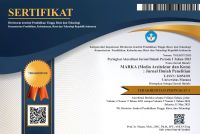Tingkat Kenyamanan Pengguna pada Studio Arsitektur: Studi Kasus Studio Arsitektur Institut Teknologi Sumatera
Abstract
The Architecture Studio is a supporting facility in the Architecture study program where many activities are carried out to carry out assignments. However, there is a tendency that students spend a lot of time outside the studio room doing assignments. Based on these problems, an analysis of user comfort is the aim of this research, especially for students. The research method used in this study is a qualitative method that involves interviewing space users and quantitatively involves taking direct measurements using a tool called a lutron and a windmate in the architecture studio room at the Sumatra Institute of Technology, after which the measurement results are analyzed and compared with the standards set. This research was conducted by paying attention to the differences in lighting in each studio room, the temperature differences in sunny, cloudy, and overcast weather conditions, and the ventilation used in the studio room. From the measurement results, it was found that the lighting conditions in the architectural studio at the Sumatra Institute of Technology did not meet the SNI (Indonesian National Standard, 2001), and the ventilation conditions at the architecture studio at the Sumatra Institute of Technology did not meet the standard for natural ventilation while meeting the standard for artificial ventilation. The architecture studio at the Sumatra Institute of Technology is comfortable carrying out assignments based on an analysis of the activities that take place during studio hours, assistance activities, and the level of work on studio assignments.
Downloads
References
Anggraeni, D. W. (2017). Kajian Ergonomi Lemari, Meja Dan Kursi Program Studi Teknik Arsitektur (Studi Kasus: Ruang Studio Arsitektur Unika Musi Charitas Di Palembang). Jurnal Arsitektur KOMPOSISI, 11(1), 41. https://doi.org/10.24002/jars.v11i1.1105
Findeli, A. (2001). Rethinking Design Education for the 21st Century: Theoretical, Methodological, and Ethical Discussion. Design Issues, 17(1), 5–17. https://doi.org/10.1162/07479360152103796
Hopkins, D., & Harris, A. (2020). Assessment as a Tool for Learning. Creating the Conditions for Teaching and Learning, 23(4), 75–84. https://doi.org/10.4324/9781315068923-14
Liliany Sigit Arifin, & Istiawati Kiswandono. (2002). Manajemen Pengajaran Di Studio Disain Arsitektur. DIMENSI (Jurnal Teknik Arsitektur), 30(1). http://puslit2.petra.ac.id/ejournal/index.php/ars/article/view/15761
Mappalotteng, A. M., & Syahrul. (2015). Analisis Penerangan Pada Ruangan Di Gedung Program Pascasarjana Unm Makassar. Scientific Pinisi, 1(1), 87–96.
neufert. (2002). https://www.ptonline.com/articles/how-to-get-better-mfi-results
Obeidat, A., & Al-Share, R. (2012). Quality Learning Environments: Design-Studio Classroom. Asian Culture and History, 4(2). https://doi.org/10.5539/ach.v4n2p165
Opiyo Lueth, P. L. (2008). The architectural design studio as a learning environment: A qualitative exploration of architecture design student learning experiences in design studios from first- through fourth-year. ProQuest, 239.
Santoso, E. I. (2012). Kenyamanan Termal Indoor Pada Bangunan Di Daerah Beriklim Tropis Lembab. Indonesian Green Technology Journal, 1(1), 13–19.
SNI. (2000). SNI 03-6197-2000 Konservasi Energi Pada Sistem Pencahayaan. Sni 03-6197-2000, 17.
Taneli, Y., & Tok, S. Y. (2010). An alternative assessment scale for student work produced in the architectural studio. Procedia - Social and Behavioral Sciences, 2(2), 2024–2028. https://doi.org/10.1016/j.sbspro.2010.03.275
Tumusiime, H. (2013). Learning in Architecture: Students’ Perceptions of the Architecture Studio. AAE Conference 2013, 1–6.
Wisnu, & Muji Indrawanto. (2017). Evaluasi sistem pencahayaan alami dan buatan pada ruang kerja. Teknik Arsitektur, Universitas Marcubuana, 07, 41–46.
- Abstract 0
- PDF (BAHASA INDONESIA) 0
Copyright (c) 2023 Tri Hartono, Kustiani Kustiani

This work is licensed under a Creative Commons Attribution-ShareAlike 4.0 International License.




















